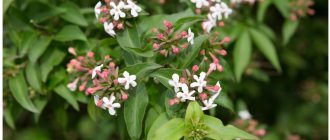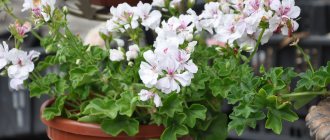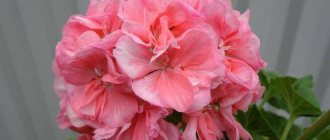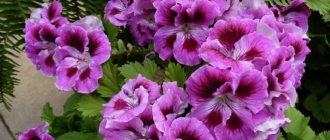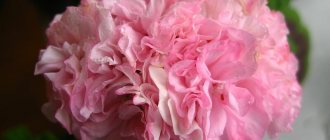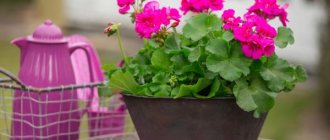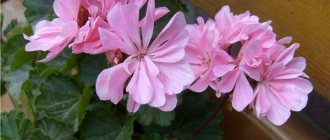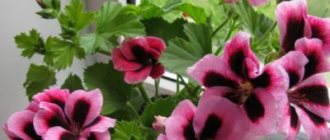Botanical description of the plant
The plant is popularly called royal geranium, although it belongs to the genus Pelargonium of the Geraniaceae family, subclass Rosidae. It has a lot of alternative names: domestic pelargonium, large-flowered, English, noble. It was bred artificially and came from closed-leaf pelargonium (cap geranium).
It is a potted plant but can grow into large bushes in mild climates. This geranium differs from other representatives in the shape and structure of the flower, as well as the splendor and arrangement of the inflorescences (not above the bush, but flush with the leaves). It blooms when it gets warm - from about April to August. The table below provides a brief description of the main morphometric parameters.
| Parameter | Description |
| Root system | fibrous |
| Stem | Erect, dense, almost completely hidden under the leaves |
| Leaf Shape | Simple, lobed, with a wavy, sometimes jagged edge |
| Leaf color | Greens |
| Flower shape | Large (usually from 4 to 7 cm), most often double, collected in umbrella-shaped inflorescences. Irregular, zygomorphic with only one plane of symmetry. The flower has a long nectar-bearing spur fused with the peduncle |
| Flower color | Varied: white, pink, red, lilac, maroon, purple. Characterized by dark veins and spots |
| Taste of Flowers | Bitterish, with a fruity minty note and rose aroma |
| Fruit shape | A long, narrow box with sepals, similar to the beak of a bird (hence “pelargos”, in Greek - “stork”) |
| Fruit color | Green, brown when ripe. |
Description
Grandiflora is a small shrub, strewn with wonderful lush buds during the flowering period. Sometimes this variety is also called English, although the exact place of origin of the variety is still unknown.
Reference . In England, Grandiflora is better known as the “royal” or “show” variety, while in the USA the flower is called “Lady Washington”.
This plant is valued and loved by flower growers all over the world - primarily for its unusually beautiful flowers - large and lush. Interestingly, pelargonium Grandiflora has no aroma, and the flowering period is shortened .
Thus, Grandiflora blooms for only three to four months. While most other varieties of geraniums can remain decorative for six months.
Reproduction
The easiest way to propagate domestic pelargoniums is cuttings. To do this, cuttings are cut from a well-developed mother plant from the top of the shoot, with 4 - 5 leaves, which must be placed in a bowl of water, where you can add aloe juice, honey or a little yeast. In such conditions, the cuttings will very quickly produce roots, after which the finished material can be planted in a pot with greenhouse or garden soil and kept for several days in a dark place for quick rooting.
You can propagate pelargonium by seeds, then the plant turns out to be more compact; with such propagation, abundant flowering is observed in large inflorescences, but this is a troublesome task for beginners, inexperienced gardeners.
Transfer
For several years, royal geranium can grow quietly in one pot. In addition, it is painful to transplant into open ground in the summer, unlike other varieties. The procedure is carried out only when the root system has completely filled the planting container. The new pot should be 1.5 cm larger than the previous one. A pot that is too large will slow down the growth of the flower and cause a prolonged absence of flowering.
Attention! Due to frequent transplants and changes in location, royal pelargonium may die
Royal geranium does not tolerate frequent transplants
It is better to plan geranium transplantation work for the period from February to April. Having emerged from the dormant period, the plant takes root well and enters the active growth phase. In summer and winter, unless absolutely necessary, you should not disturb the flower.
How does Grandiflora reproduce?
Pelargonium Grandiflora reproduces in three main ways:
- seeds;
- cuttings;
- air layering.
Seeds
Reproduction of pelargonium Grandiflora by seeds is considered one of the most difficult and troublesome. Only experienced gardeners resort to it, but at the end they can get compact plants with abundant, large flowers. The procedure in this case:
- Choose a time - February.
- Treat the seeds with a weak solution of manganese.
- Prepare a soil mixture of river sand and peat, or peat alone.
- Sow the seeds and sprinkle with a small layer of soil.
- Moisten the plantings generously with a spray bottle.
- Cover the box with film.
- Place it on the windowsill.
- Periodically ventilate and moisten the plantings.
- After about 3 weeks, the first shoots will appear. When three true leaves are formed on them, pick them into separate containers.
- For greater bushiness, pinch the plants above the sixth leaf.
- When the soil and air warm up enough, move the flowers to the garden for a permanent residence or plant them in pots.
Cuttings
This method of reproduction is one of the simplest. Even a novice florist can handle it:
- Choose a time - June.
- Cut off the upper parts of shoots 10-12 cm long from pelargonium Grandiflora.
- Remove the lower leaves.
- Prepare light sandy soil.
- Place the cuttings in it.
- Place the container in a bright place, but not in direct sunlight.
- Water, spray in hot weather.
- When young shoots appear, plant them in pots or transfer them to the garden.
Air layering
Quite an interesting method of propagation, which requires certain skills and abilities from the grower:
- Measure the length of the cutting from the top of the shoot - approximately 10 cm.
- Make an oblique cut one third of the diameter of the stem.
- Sprinkle the cut with a root formation stimulator, such as Kornevin.
- Place a piece of match or toothpick inside. This is necessary to prevent fusion of tissues of pelargonium Grandiflora.
- Below the cut, wrap the stem with damp sphagnum moss, and wrap it with a cuff of film on top.
- Care for the plant in the usual way, not forgetting to moisten the moss.
- After 2 weeks, when the roots appear, cut the cuttings 1.5 cm below the cuff.
- Transfer it to a new substrate - a pot or garden.
Breeding and planting
It is very easy to propagate geraniums vegetatively. In spring or summer, it is necessary to cut off the tops of stems with several nodes. Sprinkle the damaged area with activated carbon powder and place it on paper in the shade to dry for a couple of hours. During this time, prepare the substrate for planting. Mix peat and sand in a container. Plant the cuttings in moist soil. Cover with polyethylene to create a greenhouse effect. This will better regulate substrate humidity and heat.
In water, shoots very rarely take root and more often rot. Periodically, using a spray bottle, you should moisten the soil of the “babies”. After about 3-4 weeks, the cutting will take root. Then it can be planted in a permanent place, in a larger container. The soil should consist of leaf and turf soil, sand. The “babies” can bloom as early as July.
It is important to know that pelargonium does not like free space, so the pot is selected so that the roots are a little cramped. Transplantation is carried out after flowering no more than once every 2-3 years.
After the procedure, flowering may decrease. During the transplantation process, all weak and elongated shoots are removed
You need to move it very carefully so as not to injure the root system. Good drainage must be ensured
It is better to purchase ready-made fertile soil at a flower shop.
Caring for large-flowered pelargonium grandiflora
Pelargonium Dovepoint - description, planting and care
The royal variety of flower also requires compliance with certain care rules. Therefore, before purchasing this flower, you need to familiarize yourself with them.
Temperature
During the period of active growing and flowering, which lasts from the beginning of spring to mid-autumn, the maintenance regime should be within +20..+27 degrees. But, from mid-October to the end of January, grandiflora is in a dormant stage, so it is important to provide it with a temperature of about +12..+17 degrees.
Thanks to the cool conditions during this period, the plant gains strength for lush flowering in the new season.
Watering and spraying
Pelargonium grandiflora is drought-resistant, but the roots should not be allowed to dry out. Therefore, it is recommended to water when the top layer of soil in the pot dries out. To do this, it is recommended to use rain or settled water at room temperature.
During hot periods, it is recommended to moisten the soil 2-3 times a week, and in autumn-winter once every 7 days. This pelargonium does not need foliage spraying.
Grandiflora should be watered after the top layer of soil has dried.
Loosening
After each watering, it is recommended to slightly loosen the soil in the pot to improve air access to the roots.
Attention! This must be done carefully so as not to damage the roots of the flower.
Air humidity
Royal pelargonium is able to grow and develop in both dry and humid air. But the maximum level of decorativeness is achieved when grown in moderate humidity indoors.
Feeding
Royal pelargonium requires nutrients to grow and bloom. Therefore, the flower needs to be fertilized regularly.
In spring and summer it is recommended to do this every 10 days, and in autumn and winter - once every 3 weeks. For fertilizing, you should use special fertilizers for pelargoniums or flowering crops, which can be purchased at any flower shop.
Trimming
To form a lush compact bush, pelargonium grandiflora must be pruned in the fall. During this period, shoots should be shortened by 1/3, and all dried and damaged areas should be removed.
Important! If there are too many shoots, then pruning should be carried out in several stages at intervals of 1 month to minimize stress.
Transfer
Pelargonium grandiflora belongs to the category of flowers that do not really like transplanting. Therefore, this procedure should be carried out only if the plant has slowed down, the buds and leaves have become smaller.
Royal pelargonium does not tolerate transplantation well
Diseases and pests of pelargonium
Gray rot. Symptoms: the lower leaves become covered with brown spots, which later spread throughout the plant. The leaves change color and dry out. Some areas of the flower are covered with a gray coating. Reasons: waterlogging of the soil, lack of ventilation, increase in nitrogen in the soil. Treatment: treat the flower with fungicidal agents.
Alternaria blight. Symptoms: petioles, leaf margins and leaf blades are covered with dark spots with a light center. The spots have a velvety formation. The leaves change color and dry out. There is no flowering. Causes: problem in the soil. She's infected. Treatment: proper care, treatment with fungicidal preparations.
Rhizoctonia rot. Symptoms: the appearance of dark spots on the stems, they are depressed in nature, the spots rise 25 cm along the stem. Leaves change color and wilt. The plant does not bloom. Cause: contaminated soil. Treatment: soil change, fungicide treatment.
Verticillium wilt. Symptoms: change in leaf color, blackening, wilting, no flowering. Reason: using the same primer for a long time. Treatment: get rid of remnants of vegetation in a timely manner, use clean substrates, and monitor soil moisture.
Rust. Symptoms: clearly shaped reddish spots appear on the plant. Causes: infection through water and air. Treatment: stop watering, trim leaves, treat with fungicidal agents.
Late blight of geranium. Symptoms: rapid decay, dry leaves, stops blooming, depressed spots on the roots. Causes: the infection is in the soil. Improper care, elevated temperature, excess fertilizer. Treatment: use the right soil, ventilate the soil, stop watering, treat with antibacterial drugs.
Rotting of stems and roots. Symptoms: flowering stops, fades, dies. Dark brown depressed formations appear on the neck and root. Later, suppuration of the affected areas begins. Reasons: contaminated soil, improper care, poor lighting, increased air temperature, increased nitrogen readings in the soil. Treatment: reduce watering, treat with fungicidal agents.
Leaf spotting and curling. Symptoms: does not bloom, spots on the leaf, grow over time, have a yellow color, sometimes the structure becomes oily. Causes: changes in leaf nutrition, the plant is affected, infectious insects can carry it. Treatment: treatment with fungicide. When propagating, use healthy plants.
Description of culture
Large-flowered pelargonium is a compact bush, the height of which reaches 60 cm. Its erect stems are shrouded in bright green foliage, and large flowers are located on top, their diameter reaches 7 cm. They are:
- collected in inflorescences 25 cm in diameter;
- differ in various shapes.
The color of the petals can range from white to dark purple. With proper care, the flowering period can last 3-4 months.
Difficulties in growing
When growing and caring for Royal pelargonium at home, gardeners often encounter difficulties. The most common problems are:
- Yellowing of leaves. The reason for this can be determined by carefully examining the flower. If the leaf is elastic and only the tips turn yellow, then most likely the plant does not have enough moisture. If the leaves are limp and rotting, the reason may lie in the opposite - in overwatering.
- The foliage turns red. This may occur due to the room temperature being too low. The plant should be removed to another place, away from the window.
- Falling leaves. This problem usually occurs due to insufficient lighting, excess nitrogen content in the soil or excessively dry indoor air.
The plant should be replanted every 2-3 years.
The most common question among amateur gardeners is why pelargonium does not bloom. Such a nuisance can be caused by many reasons, among which the most common are:
- Fungal infections and rot. A careful inspection of the leaves, stem and root zone should be carried out. The affected areas of the plant should be removed and the flower treated with fungicides.
- An overly spacious pot: as already mentioned, Royal geranium blooms more readily in a cramped pot.
- Insufficient lighting. In this case, the stems lengthen excessively and the flower stalks do not develop.
- Low air temperature in spring and winter or excessively high in summer.
Proper care of pelargonium at home will ensure annual abundant and long-lasting flowering of the plant. The main thing is to care for it with love, then the flower will delight its owners with its beauty for a long time.
Brief conclusions
- The flowering of the royal pelargonium Grandiflora can be observed for quite a long time - 3-4 months. To do this, it is enough to provide him with high-quality care.
- The easiest way to propagate the plant is by cuttings, although geraniums can also be grown from seeds.
- The crop requires a lot of light and high air temperature, regular feeding, but the level of humidity is not critical - the air can even be dry, the plant will survive this relatively painlessly.
- When caring for geraniums, you should regularly inspect them for the presence of pests and diseases and carry out their prevention, because they often kill the entire bush.
Variety of species
Due to its attractive appearance and ease of care, the flower attracts the attention of not only indoor plant lovers, but also breeders who have bred a large number of geranium varieties. Hybrid varieties differ in the size of the bush, color and shape of leaves and flowers
Particularly popular among gardeners is variegated and dwarf pelargonium, with bicolor and double flowers. Thanks to the work of breeders, about 300 species of this indoor plant have been bred. Pelargonium can have different forms: shrub, subshrub or herbaceous plant.
Depending on the variety, geranium is used to decorate rooms, garden plots, balconies and loggias. Varieties of ampelous, succulent, and fragrant pelargonium have been developed. At home, large-flowered varieties of pelargonium are usually bred.
Indoor pelargonium. The plant has dark green leaves with dark brown edges. The width of the border may vary depending on the variety of geranium. Sometimes it is called the “grandmother’s” flower. Indoor geranium flowers are varied. The plant can have simple, double and semi-double flowers, having different shapes and number of petals.
Pelargonium ivy-leaved. This is an ampelous plant with flowing long shoots, the length of which can exceed one meter. Pelargonium is often planted in hanging flowerpots. The geranium leaves of this variety are smooth, glossy, and bright green. Outwardly, they look like ivy leaves. This similarity is why the variety got its name.
Geranium Angel. This is also a hanging variety, but with shorter shoots
Particular attention is drawn to the flower, which resembles the shape of a pansy. The flowers are arranged in inflorescences, looking like bouquets.
Geranium fragrant
This type of pelargonium is loved by gardeners for its variety of scents. Fragrant varieties of pelargonium contain a large amount of phytoncides, thanks to which the leaves of the flower have a unique aroma. The aroma is especially strong when you touch the flower. Externally, the plant is not as attractive as flowering species. Fragrant pelargonium has large, slightly grooved leaves with slight pubescence on the surface of the leaf blade. The size of the leaves is quite large with uneven serrated edges. The flowers are simple white or pink. This species is characterized by strong shoot growth. Therefore, it needs the formation of a bush. To form a beautifully shaped shrub, you should periodically pinch the tops of the shoots.
Royal geranium. One of the most beautiful types of pelargonium. Particular attention is drawn to large flowers, which are collected in large inflorescences of large sizes. As a result, the inflorescence cap looks gigantic. The petals can have a variety of colors, their surface can be decorated with veins, borders, spots or specks.
Geranium Unicum. This variety of flower combines the best features of other species. Its flowers are distinguished by unusual colors with veins and patterns on the surface. The leaves of the shrub also have decorative qualities and have a light aroma.
Miniature geraniums. These species are represented by small-sized shrubs. They do not require additional pruning and crown formation. They are well suited for home keeping. Dwarf or miniature pelargoniums combine several varieties:
- Rosaceous geraniums - their flowers look like pink buds collected in inflorescences;
- cactus-shaped geraniums - flowers have an unusual shape. Their petals are cone-shaped and curled into the shape of cactus spines;
- star geraniums - flower petals are slightly pointed at the tip, quite narrow and look like stars;
- carnation pelargoniums - the flowers look like carnations because they have jagged, needle-like petals.
https://youtube.com/watch?v=p3m8V92rtNc
Description of Pelargonium Grandiflora
Royal pelargonium is a close relative of the zonal variety of the crop. But it cannot be found in natural conditions, since it was obtained as a result of crossing other species. Therefore, the plant differs from its fellows not only in external characteristics, but also in its whimsical conditions of detention.
Pelargonium grandiflora features exquisite flowers
History of the century
The first varieties of grandiflora appeared at the end of the 18th century and were of English origin. They were obtained by improving the flower size of common species that were introduced from the Cape Province of South Africa.
But already in 1834, French breeders made their own adjustments to the process of obtaining royal pelargonium. Therefore, during this period, varieties and species with contrasting veins and two bright spots on the upper petals appeared. This group of royal pelargoniums was named Diadeatum.
The decisive step in the selection of grandifloras was taken by the gardener James Odier, who managed to ensure that the veins on the petals turned into spots, and in the end there were 5 of them in the flower.
Peculiarities
Geranium grandiflora, as the flower is sometimes mistakenly called by ordinary people, forms a bush up to 50 cm high and at the same time grows wider than upward. Its leaves are densely located on the shoots. The plates are large, round, rough to the touch, jagged along the edge. They can be light or dark green. The root system is fibrous.
Grandiflora bushes are compact
The royal variety has flowers with 5 petals. Moreover, the top three are much larger, and the bottom two are smaller. The petals overlap each other. Flowers can be simple or double. The color of the petals is very diverse: from white, pink and orange to red and dark cherry. The petals may be corrugated and wavy, and have a bright spot or stripes.
Attention! The difference between grandifloras is that the peduncles do not rise above the foliage, as in other species, but are located at the same level. During the flowering period, the bush is an unforgettable sight, which is why flower growers fell in love with royal pelargonium.
Due to the high decorative qualities of the plant, it is widely used to decorate glazed balconies, terraces, loggias and home interiors. The flowering period of grandiflora begins in April-May and lasts for 3-4 months, depending on the conditions of detention.
At the same time, pelargonium grandiflora is not intended for growing in the garden, since it does not bloom in open ground.
The plant is characterized by rapid growth - at the end of the first season you can get a compact bush 20-30 cm high, and already in the next season royal pelargonium reaches a standard size. As they mature, the shoots become lignified at the bottom, as in other species.
Important! The grandiflora variety does not have the characteristic smell of pelargonium, but some varieties during flowering exude a delicate aroma combining shades of rose, lime and mint.
Diseases and pests
It’s a pity, but such a beautiful plant can have health problems. The most common diseases that can affect pelargonium are:
- Powdery mildew. With this disease, a powdery coating appears on the leaves and stems of the bush. Treatment is carried out using Bordeaux mixture, Topaz, and copper sulfate solution.
- Leaf rust. When a plant is infected with a fungus, small yellowish spots appear on top of its leaf blades, and rust-colored pads appear below. It will not be possible to save a diseased flower. It should be thrown out along with the soil. To prevent fungal diseases, you need to use well-drained soil, do not overwater the plant, and prevent it from overcooling.
- Root rot. The appearance of brown damage on the stems and a gray coating on the leaves indicates that the plant has rot on the roots. It should be destroyed.
- Necrotic viral spots. Purple-brown lesions appear on a flower affected by the virus. Such a plant is destroyed. Viruses are transmitted by pests, so when they appear, it is necessary to use insecticides.
- Leaf spotting. The fungal disease appears as blistering spots on the underside of the leaf blade. Infected leaves must be cut off and the bush treated with fungicidal preparations.
Pelargonium is not spared by pests either. Of these, geraniums are most often inhabited by:
- Aphids are small green or gray insects that can be found on the undersides of leaves. Their presence can also be recognized by small spots on the foliage, which fades and falls over time. To destroy aphids, it is necessary to treat the bush with an insecticidal preparation.
- Whitefly – These moth-like insects live on the underside of leaves. They feed on the sap of the plant, which is why the leaves first turn yellow and fall off, and then the entire flower dies. Whiteflies multiply very quickly, so when they appear, the entire bush must be immediately sprayed with one of the insecticidal preparations.
Winter care
If, after the flowers fall, pelargonium is left on a warm windowsill until next spring, there may not be another flowering. With the arrival of autumn, when the temperature drops, the rules of care change. For three months the following must be provided:
- 12−15 °C;
- infrequent watering, only to maintain decreased activity;
- sufficient lighting.
No fertilizing is carried out in winter. If all conditions are met, the plant produces enough flower buds.
Transplantation and feeding
All pelargoniums have rapidly growing aerial parts. If the roots of a bush that has grown over the summer, together with the soil from the pot, have entwined an earthen ball, at the end of winter the geranium is replanted. The soil should be loose, allow enough air to pass through and retain moisture. As for selecting a soil mixture, a good option is a mixture of equal parts of sand, peat and disinfected garden soil.
Since the roots do not tolerate stagnant moisture, pelargonium needs a powerful drainage layer
When planting, no less attention is paid to the choice of pot. Geraniums do not bloom due to transplantation into too large containers
In a large pot, the plant very quickly grows green mass, but “ignores” the set of buds. A similar process is also observed with an incorrectly selected fertilizer mixture. When there is more nitrogen in fertilizers during bud formation and flowering, the stems and leaves grow, and the number of buds decreases. The best mixtures have a high content of phosphorus and potassium, which ensures long-term abundant flowering.
Plant pruning
Royal pelargonium may not bloom due to improper or insufficient pruning. Since the flower grows quickly and the buds form at the tops of the shoots, it is easy to increase the number of flower buds by pinching or trimming the tops of overgrown stems in July and August. Thanks to this it is possible to:
- Obtain cuttings for propagation.
- Achieve lush flowering next season.
- Stimulate the growth of fresh shoots.
- Make the bush compact and attractive.
It is recommended to prune gradually so as not to seriously injure the plant. After this procedure, pelargonium must be fed. Pruning is completed at the end of winter, when new bud formation begins.
Maintenance and care
The royal plant requires good lighting, but needs protection from direct sun. It is best to keep it under artificial lighting, but it is also possible on a window, with the exception of one facing the north. If pelargonium does not have enough light, it may not bloom or its flowers will be small. When kept on a window in the hot season, it needs shading, otherwise burns may appear on the leaves. In summer, it is better not to take the plant out into the open air; it is afraid of rain and winds. In summer, the ideal place to keep it is a glazed veranda or loggia. In winter, pelargonium needs a cool temperature of around +15 degrees, otherwise all its energy will be spent on surviving in hot conditions, and there will be no left for flowering. In addition, if temperature conditions are not observed, plants are often attacked by pests, for example, whiteflies and aphids.
Pelargonium grandiflora loves abundant watering, but does not tolerate waterlogging, so it needs good drainage. It is better to take soft, settled water for irrigation, and moisten the substrate only after its top layer has dried. When the soil becomes too wet or dry, the beauty instantly loses its color. You can spray the plant only when it is not blooming; water stains appear on the flowers. For abundant flowering and the formation of new shoots, pelargonium is regularly pinched. In the spring and summer, it needs to be fed with mineral fertilizer with a high potassium content, and during the flowering period - with any fertilizer for flowering indoor plants. To maintain an aesthetic appearance during the flowering period, faded flowers should be plucked off.
Home care
Watering and loosening the soil
Pelargonium needs constant and abundant watering. But it should be remembered that waterlogging should not be allowed. Otherwise, there is a high probability of rotting of the root system. A break between procedures is necessary. Until the top layer of soil dries, you should not water. Use soft water that has stood for several days.
If the gardener notices that Grandiflora drops its flowers immediately after they appear, it means the soil is too wet. In this case, you need to wait until the next watering. But if the leaves dry out and turn yellow, this is a clear sign of a lack of fluid.
Pelargonium does not need spraying. Water that gets on the petals causes stains and stains, which only spoil the decorative effect. Loosening is an integral part of care. With this procedure, fresh air freely enters the soil.
Loosening is carried out after watering, once every 2-3 months.
Before pelargonium Grandiflora begins to bloom, nitrogen fertilizers containing calcium are needed. When the inflorescences begin to form, nitrogen fertilizing is stopped.
You should not apply fertilizer too much or too often, because having an excess of minerals in the soil, the leaves of the plant turn yellow.
To maintain the compactness of the bush, timely pinching of growing shoots is required. New inflorescences are not formed if there are dry buds on the flower, so they are removed.
The pruning procedure is done in the fall. In order not to injure the pelargonium, the shoots are removed in stages, and not all at once.
The pet has a bad attitude towards transplants. It is better not to touch an adult bush that is fully formed unless absolutely necessary.
Planting large-flowered pelargonium
Violet - flower care at home
Pelargonium grandiflora is very demanding in terms of care and maintenance conditions. Therefore, novice gardeners need to take this into account. Failure to comply with the basic requirements of the culture can cause the absence of buds throughout the entire season.
For the plant, it is necessary to select small pots with drainage holes, the volume of which will be 2 times larger than the root system.
For the royal variety, you cannot select large pots
Choosing a location and lighting
Royal pelargonium needs good lighting. Therefore, it is recommended to place the flower pot on the lightest windowsill in the house with light shading from direct sunlight, so that burns do not appear on the leaves.
In winter, for the bush to fully develop, it is necessary to provide at least 10 hours of daylight. Therefore, in the evening, phytolamps should be turned on.
Important! With a lack of light, the flower does not form buds, and its shoots become elongated.
Priming
For the royal variety, you should purchase a substrate intended for growing pelargoniums. It has good moisture and breathability and a balanced composition. If such soil is not available in the store, you can prepare it yourself by combining the following components:
- 1 part - turf;
- 1 part - humus;
- 1 part - sand;
- 1 Part - peat.
Before planting, you should lay a 1.0 cm layer of expanded clay on the bottom of the pot. And then sprinkle it with a nutrient substrate. Place the flower in the center of the container, without deepening the root collar, and fill the resulting voids with soil.
After planting, water the plant generously and place it in a shaded place for 2-3 days.
Landing rules
Let's get acquainted with the basic rules regarding planting dwarf pelargonium.
Lighting and location selection
Important! In order for dwarf pelargonium to bloom beautifully and for a long time, it needs to grow in a well-lit place. With enough sunlight, the plant's petals are brighter and greener.
If pelargonium experiences a lack of light, its decorative effect will fade: there will be fewer inflorescences and the leaves will turn pale.
However, the plant does not tolerate direct rays: at midday, therefore, it is recommended to shade pelargonium. In winter, so that the flower does not lose its decorative effect, it needs to be provided with additional artificial lighting.
In order for the crown of the plant to form compactly, it is recommended to periodically turn the pot towards the window with different sides. This way, the sun's rays will be able to reach all parts of the plant, and the pelargonium will stretch evenly.
Temperature
In summer, pelargonium should be kept in moderate temperatures: +17+23 degrees will be ideal. The plant should not be allowed to overheat. It is better for a flower to overwinter at a temperature of +12-13 degrees, not higher, since at this time the plant should slow down all its vegetative processes and rest.
The soil
Note that dwarf pelargonium is not too demanding on the composition of the soil. The main thing in this case is to provide the plant with good drainage so that the moisture in the pot does not stagnate.
Soils with a neutral or slightly alkaline reaction are best suited for the plant. If the soil is acidic, it is recommended to neutralize it with ash. The recommended substrate composition is as follows:
- part of the humus;
- part of the leaf soil;
- part of the turf;
- part of the river sand.
Reproduction of indoor pelargonium
There are several ways to grow geraniums. You can simply choose the most suitable one for yourself.
Indoor geranium
Dividing the bush
There are situations when adult plants are propagated by dividing the bush into two approximately equal parts. The varietal affiliation in this case is not important; the method is suitable for all geraniums.
You need to remove the pelargonium from the pot, carefully shake off the soil from the roots and divide them into two parts. The bush itself is cut with a sharp and disinfected knife. The sections are treated with crushed activated carbon.
Each individual part is planted in its own pot. The plants will quickly come into shape and bloom.
Growing geraniums from cuttings
This is one of the most common methods of propagating pelargonium. It is necessary to cut the stem cuttings, their length should be up to 10 centimeters. The lower pair of leaves are torn off. Then the cuttings are left to lie in the air for a couple of hours. A film should appear on the sections. It is very important to sprinkle them with crushed activated carbon, and then place them in a slightly damp substrate.
Pots with plants are sent to a well-lit place, but not directly under the sun. The next day you can start watering, but this must be done very carefully. After a month, roots will appear, then the geranium can be transplanted into a permanent pot. Further care is the same as for adult plants. To make the bush more full at the growing point at the top, you need to pinch it.
Propagation by seeds
Pelargonium can also be grown through seeds. Some gardeners suggest that such plants bloom more luxuriantly and profusely. It is worth noting that this method is very labor-intensive.
It is recommended to buy seeds exclusively in special stores.
Sowing is carried out in January or February. The seeds are laid out on a slightly damp surface of the substrate in a container, and then the lid is closed. The container is placed in a warm, dark place. After a couple of weeks, the first shoots will appear.
Then the container should be moved to a bright place and the lid should be opened periodically to ventilate the plants.
As soon as the seedlings have two true leaves, pick them. The temperature of further maintenance should be reduced to +16-18 degrees. After a couple of months, you can plant the geranium in small pots and care for it like an adult indoor flower.
Appearance and features
After some time, the lower part of the pelargonium becomes woody, turning it into a compact, neat bush.
The foliage has different color shades. Most often - light green and dark green. They are round in shape, with teeth along the edges.
A distinctive feature of Grandiflora is its luxurious, large flowers. Their diameter can reach 6 centimeters. There are similarities with pansies. The color is very diverse: soft pink, bright red, purple and many other shades of these colors. The flower stalks are at the same level as the leaves. Due to this feature, the plant looks like a spectacular ball.
Pelargonium’s inflorescences collected in dense umbrellas give the external attractiveness and decorativeness. The bush itself does not exceed 30 centimeters in height. Mainly growing in width.
About geranium and pelargonium
Many people believe that pelargonium is a geranium, but in fact they are just similar plants that belong to the same family Geraniaceae. Visually they are largely the same. And geranium and pelargonium are unpretentious in care. They also have such an important quality as suitability for traditional medicine.
Seafarers from southern countries brought indoor geraniums to Europe. In its homeland, this crop grows in the wild and is a subshrub with strong shoots, smooth and slightly pubescent leaves, with umbrella inflorescences most often, although some subspecies also have single flowers.
It is difficult to identify common features that will be characteristic of the entire Geraniaceae family. There are herbaceous varieties, creeping, straight, branched, and shrubby. The flowers have different shapes and sizes, but they are often collected in umbrellas.
Geranium that everyone knows
It is worth noting that breeders were unable to cross geranium and pelargonium because they have different genetic characteristics. The first comes from the northern hemisphere, while the second grows in African savannas. So pelargonium feels best on warm windowsills, and geranium can bloom in gardens and meadows until cold weather.
